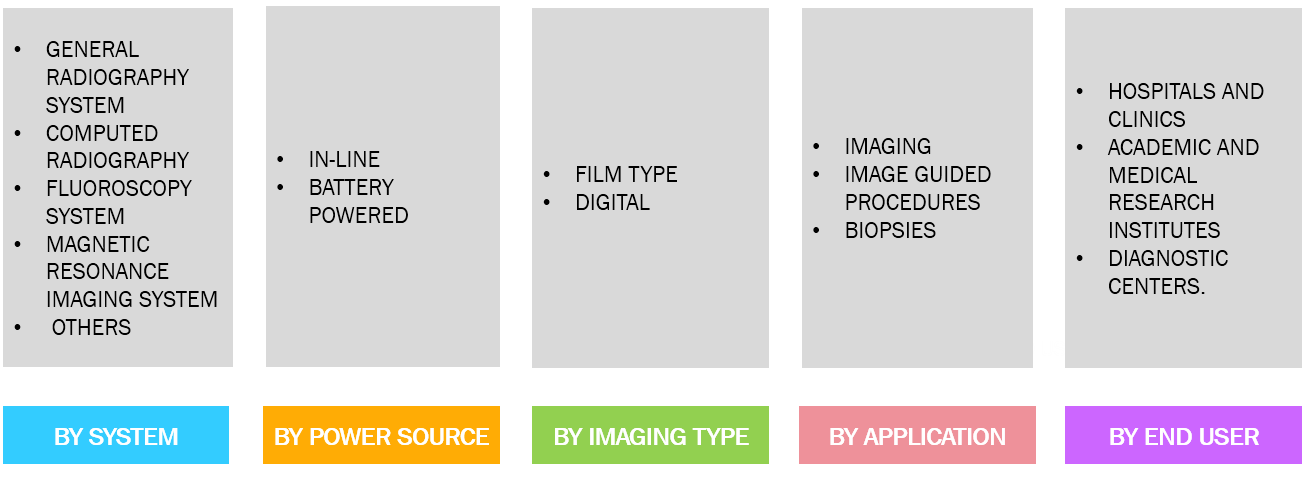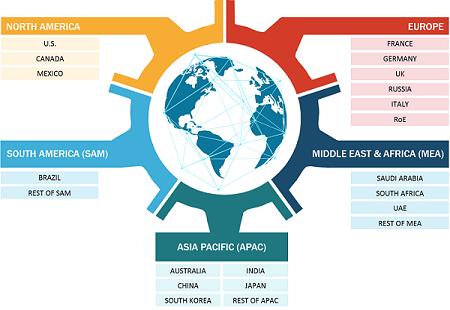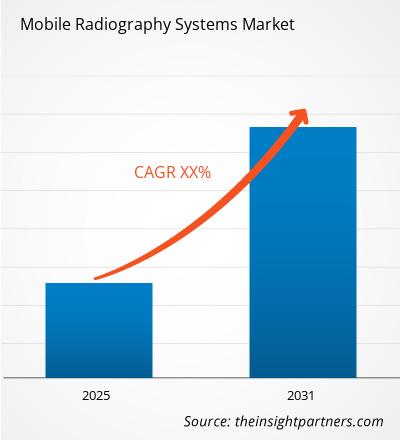市场介绍
放射线照相术是一种成像技术,使用伽马射线、X 射线和其他电磁辐射对人体内部进行成像。移动射线照相主要用于无法运送到医学影像室的患者的床边射线照相检查。
市场动态
移动放射成像由于糖尿病、心血管疾病等慢性病发病率的增加、技术先进的医疗保健设备的不断采用、老年人口的增加、医疗保健的进步以及越来越多的人口增长等因素,系统市场预计将在预测中增长。的医学成像程序。
市场范围
《2031 年全球移动放射成像系统市场分析》是对医疗器械行业的专业深入研究特别关注全球市场趋势分析。该报告旨在提供移动放射成像系统市场的概述,并按系统、电源、成像类型、应用、最终用户和地理位置进行详细的市场细分。预计全球移动放射成像系统市场在预测期内将出现高速增长。该报告提供了领先的移动放射成像系统市场参与者的市场状况的关键统计数据,并提供了市场的主要趋势和机会。
市场细分
全球移动放射成像系统市场根据系统、电源、成像类型、应用和最终用户进行细分。根据系统,市场分为普通放射成像系统、计算机放射成像、荧光检查系统、磁共振成像系统等。根据电源,市场分为串联式、电池供电式。根据成像类型,市场分为胶片类型、数字类型。根据应用,市场分为成像、图像引导程序、活检。根据最终用户,市场分为医院和诊所、学术和医学研究机构、诊断中心。

该报告提供了行业的详细概述,包括定性和定量信息。它提供了基于各个细分市场的全球移动放射成像系统市场的概述和预测。它还提供了 2021 年至 2031 年五个主要地区的市场规模和预测估计,即:北美、欧洲、亚太地区 (APAC)、中东和非洲 (MEA) 以及南美和非洲中美洲。每个地区的移动放射成像系统市场随后按各自的国家和细分市场进行细分。该报告涵盖了对全球 18 个国家以及该地区当前趋势和机遇的分析和预测。
该报告从需求和供应方面分析了影响移动放射成像系统市场的因素,并进一步评估了预测期内影响市场的市场动态,即驱动因素、限制因素、机会和未来趋势。该报告还为所有五个地区提供了详尽的 PEST 分析,即:北美、欧洲、亚太地区、中东和非洲以及南美洲和南美洲中美洲在评估影响这些地区移动放射成像系统市场的政治、经济、社会和技术因素后。

- 历史分析(2 年)、基准年、预测(7 年)及复合年增长率
- PEST 和 SWOT 分析
- 市场规模价值/数量 - 全球、区域、国家
- 行业和竞争格局
- Excel 数据集


- Medical Devices Market
- Dealer Management System Market
- Public Key Infrastructure Market
- Small Molecule Drug Discovery Market
- Green Hydrogen Market
- E-Bike Market
- Foot Orthotic Insoles Market
- Health Economics and Outcome Research (HEOR) Services Market
- Wire Harness Market
- Aesthetic Medical Devices Market

Report Coverage
Revenue forecast, Company Analysis, Industry landscape, Growth factors, and Trends

Segment Covered
This text is related
to segments covered.

Regional Scope
North America, Europe, Asia Pacific, Middle East & Africa, South & Central America

Country Scope
This text is related
to country scope.
Trends and growth analysis reports related to Life Sciences : READ MORE..
The List of Companies
- GE Healthcare
- AGFA Healthcare
- Innomed Medical Developing and Manufacturing
- Konica Minolta
- Philips Healthcare
- Idetec Medical Imaging
- DMS Imaging
- BMI Biomedical International
- CAT Medical
- Shimadzu.
The Insight Partners performs research in 4 major stages: Data Collection & Secondary Research, Primary Research, Data Analysis and Data Triangulation & Final Review.
- Data Collection and Secondary Research:
As a market research and consulting firm operating from a decade, we have published and advised several client across the globe. First step for any study will start with an assessment of currently available data and insights from existing reports. Further, historical and current market information is collected from Investor Presentations, Annual Reports, SEC Filings, etc., and other information related to company’s performance and market positioning are gathered from Paid Databases (Factiva, Hoovers, and Reuters) and various other publications available in public domain.
Several associations trade associates, technical forums, institutes, societies and organization are accessed to gain technical as well as market related insights through their publications such as research papers, blogs and press releases related to the studies are referred to get cues about the market. Further, white papers, journals, magazines, and other news articles published in last 3 years are scrutinized and analyzed to understand the current market trends.
- Primary Research:
The primarily interview analysis comprise of data obtained from industry participants interview and answers to survey questions gathered by in-house primary team.
For primary research, interviews are conducted with industry experts/CEOs/Marketing Managers/VPs/Subject Matter Experts from both demand and supply side to get a 360-degree view of the market. The primary team conducts several interviews based on the complexity of the markets to understand the various market trends and dynamics which makes research more credible and precise.
A typical research interview fulfils the following functions:
- Provides first-hand information on the market size, market trends, growth trends, competitive landscape, and outlook
- Validates and strengthens in-house secondary research findings
- Develops the analysis team’s expertise and market understanding
Primary research involves email interactions and telephone interviews for each market, category, segment, and sub-segment across geographies. The participants who typically take part in such a process include, but are not limited to:
- Industry participants: VPs, business development managers, market intelligence managers and national sales managers
- Outside experts: Valuation experts, research analysts and key opinion leaders specializing in the electronics and semiconductor industry.
Below is the breakup of our primary respondents by company, designation, and region:

Once we receive the confirmation from primary research sources or primary respondents, we finalize the base year market estimation and forecast the data as per the macroeconomic and microeconomic factors assessed during data collection.
- Data Analysis:
Once data is validated through both secondary as well as primary respondents, we finalize the market estimations by hypothesis formulation and factor analysis at regional and country level.
- Macro-Economic Factor Analysis:
We analyse macroeconomic indicators such the gross domestic product (GDP), increase in the demand for goods and services across industries, technological advancement, regional economic growth, governmental policies, the influence of COVID-19, PEST analysis, and other aspects. This analysis aids in setting benchmarks for various nations/regions and approximating market splits. Additionally, the general trend of the aforementioned components aid in determining the market's development possibilities.
- Country Level Data:
Various factors that are especially aligned to the country are taken into account to determine the market size for a certain area and country, including the presence of vendors, such as headquarters and offices, the country's GDP, demand patterns, and industry growth. To comprehend the market dynamics for the nation, a number of growth variables, inhibitors, application areas, and current market trends are researched. The aforementioned elements aid in determining the country's overall market's growth potential.
- Company Profile:
The “Table of Contents” is formulated by listing and analyzing more than 25 - 30 companies operating in the market ecosystem across geographies. However, we profile only 10 companies as a standard practice in our syndicate reports. These 10 companies comprise leading, emerging, and regional players. Nonetheless, our analysis is not restricted to the 10 listed companies, we also analyze other companies present in the market to develop a holistic view and understand the prevailing trends. The “Company Profiles” section in the report covers key facts, business description, products & services, financial information, SWOT analysis, and key developments. The financial information presented is extracted from the annual reports and official documents of the publicly listed companies. Upon collecting the information for the sections of respective companies, we verify them via various primary sources and then compile the data in respective company profiles. The company level information helps us in deriving the base number as well as in forecasting the market size.
- Developing Base Number:
Aggregation of sales statistics (2020-2022) and macro-economic factor, and other secondary and primary research insights are utilized to arrive at base number and related market shares for 2022. The data gaps are identified in this step and relevant market data is analyzed, collected from paid primary interviews or databases. On finalizing the base year market size, forecasts are developed on the basis of macro-economic, industry and market growth factors and company level analysis.
- Data Triangulation and Final Review:
The market findings and base year market size calculations are validated from supply as well as demand side. Demand side validations are based on macro-economic factor analysis and benchmarks for respective regions and countries. In case of supply side validations, revenues of major companies are estimated (in case not available) based on industry benchmark, approximate number of employees, product portfolio, and primary interviews revenues are gathered. Further revenue from target product/service segment is assessed to avoid overshooting of market statistics. In case of heavy deviations between supply and demand side values, all thes steps are repeated to achieve synchronization.
We follow an iterative model, wherein we share our research findings with Subject Matter Experts (SME’s) and Key Opinion Leaders (KOLs) until consensus view of the market is not formulated – this model negates any drastic deviation in the opinions of experts. Only validated and universally acceptable research findings are quoted in our reports.
We have important check points that we use to validate our research findings – which we call – data triangulation, where we validate the information, we generate from secondary sources with primary interviews and then we re-validate with our internal data bases and Subject matter experts. This comprehensive model enables us to deliver high quality, reliable data in shortest possible time.

 获取此报告的免费样本
获取此报告的免费样本